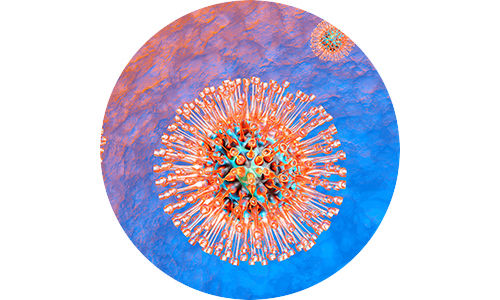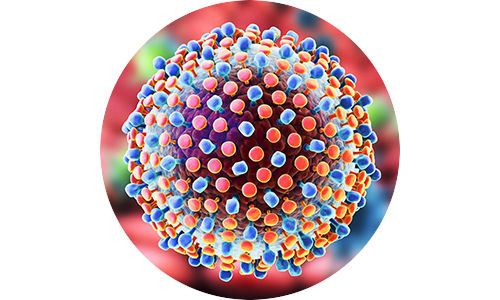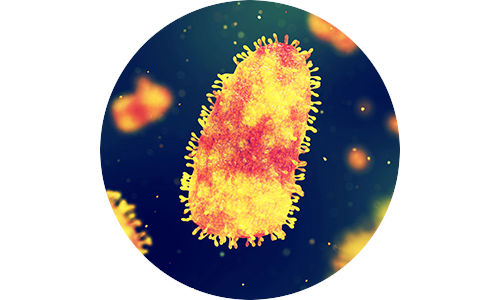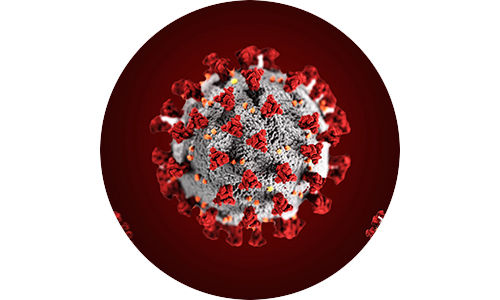
Until a few weeks ago, the word "viral" was associated, for the most part, with the language of the Internet: "a viral video", "a viral post", "it’s viral on social networks", etc. Unfortunately, since the explosion of the coronavirus pandemic, this term has returned to its authentic use, rekindling everyone's attention on viruses, tiny particles invisible with the naked eye, but powerful enough to hold the entire planet in check.
The virtual exhibition VIRAL PASSION is a journey into the world of viruses that has two main objectives: the first is that of presenting to our visitors, first of all through beautiful images, the viruses responsible for the main diseases of human history; the second is that of guiding visitors to the most serious and scientifically reliable resources on the web, so that everyone can build her/his own path of study, carefully avoiding all those hoaxes and fake news which, unfortunately, the Internet is scattered with.
And we hope that, when the pandemic is overcome, it will at least have served to restore science, research, the scientific method, the important role they have always played in the history of humanity.
Viruses are microorganisms found everywhere on Earth. They cannot reproduce on their own; to do this they need a guest. A host can be a plant, an animal or even a bacterium. Once a virus infects a host, it begins to multiply, causing a disease called infection.
Viruses can vary in shape, size and complexity. Each virus can infect certain species; but it can also quickly replicate and change. When they change they can develop the ability to infect other species. This process makes it possible for a virus to "jump", for example, from an animal to humans.
The genetic material of the viruses can be DNA or RNA and for this reason the viruses can be called respectively deoxyribovirus and ribovirus; therefore they will have different characteristics and methods of replication.
I virus sono strutture relativamente semplici costituite da un CORE contenente acido nucleico (DNA o RNA) avvolto da un involucro proteico detto CAPSIDE.
They need, in order to survive, to enter a host cell that allows them to use the necessary enzymes for REPLICATION (a process that allows the virus to duplicate itself); for TRANSCRIPTION (process that allows the virus, starting from a DNA molecule, to synthesize one of RNA). From the RNA molecule it is possible to proceed to TRANSLATION (process that allows the virus to synthesize the proteins that are used both to form new molecules of genetic material and to form the Capsid).
DNA viruses or deoxyriboviruses are viruses that use DNA as their genetic material. Once they have penetrated into the host cell, the TRANSCRIPTION begins using the enzymes of the host cell; this allows both to synthesize the viral enzymes necessary for the REPLICATION of the DNA and therefore of the VIRUS itself, as well as the proteins that constitute the capsid that is necessary for the viral assembly.
RNA viruses or riboviruses are viruses that use RNA as their genetic material. Once penetrated into the host cell they have different REPLICATION mechanisms depending on the type of their filament.
The Positive-strand RNA virus can act as messenger RNA and therefore be immediately TRANSLATED by the host cell ribosomes in order to produce viral proteins necessary for both REPLICATION and viral assembly.
The Negative-strand RNA viruses, on the other hand, serves as a template for messenger RNA; once it’s produced, the messenger RNA is TRANSLATED and then REPLICATION and viral assembly can start.
Finally, in retroviruses the reverse transcriptase (RT) converts the viral RNA into a double DNA chain that is integrated into the host cell's DNA, inducing a TRANSCRIPTION of a new viral RNA, necessary for the synthesis of viral protein (TRANSLATION) and for viral REPLICATION.

This virus, belonging to the Herpesviridae family, is responsible for both Varicella, a well-known exanthematic disease, and Herpes zoster or shingles: in this second case it is a reactivation of the virus, even many years after [...]

Isolated in 1964 by two British virologists, Anthony Epstein and Yvonne Barr, EBV is responsible for infectious mononucleosis (the “kissing disease", very common among teenagers) but is also associated with certain cancers [...]

The hepatitis B virus (HBV) is a DNA virus belonging to the Hepadnaviridae family. There are currently 6 known genotypes with a different geographical distribution. The infection by HBV is, in most cases, asymptomatic. [...]

Herpesviruses are a family of viruses that includes several subgroups responsible for various diseases. Their main characteristic is that of never leaving the host's organism, even if in the presence of antibodies. [...]

It belongs to the Papilloma viridae family and affects only humans. It is at the origin of various infections that are transmitted mainly through sexual intercourse. Papillomavirus infection (HPV - Human Papilloma Virus) is by far the most frequent [...]

It belongs to the Parvoviridae family and is responsible for the infectious erythema also known as the fifth disease, one of the typical exanthematic diseases of childhood. It is transmitted by air and confers permanent immunity. [...]

The Variola virus, of the Poxviridae family, was the agent responsible for smallpox, a disease that had a great importance in human history and that was also at the origin of the development of vaccination as a prevention tool. [...]

Influenza viruses belong to the Orthomyxoviridae family and are divided into three different types: type A, B and C based on the characteristics of their surface proteins. Type A virus is essentially an avian virus, which only occasionally adapts [...]

It is part of the Paramyxoviridae family, which also includes viruses from other diseases such as flu-like syndromes and mumps. It spreads very easily, by air, and gives a definitive immunization. Measles is a very contagious disease that often [...]

It belongs to the Picornaviridae family and causes poliomyelitis, a serious disease affecting the central nervous system and, in particular, the motor neurons of the spinal cord causing serious disabilities. Thanks to polio vaccines [...]

Hepatitis C is an infection of the liver caused by a virus belonging to the hepacivirus genus of the Flaviviridae family. Over the years since its definition, therapies for the treatment of hepatitis C have made great strides, and today it can be [...]

This virus, from the Rhabdoviridae family, can affect the nervous system of both animals and humans. Left untreated, this disease, which causes acute brain inflammation, can lead to death. However, there is a vaccine, which is used in the event [...]

Ebola virus disease (EVD), a severe bleeding fever, is often fatal to humans. The virus RNA of the Ebola kind are part of the family Filoviridae and different species have been identified, of which some associated with a large epidemics in Africa. [...]

HIV is the virus responsible for AIDS, the acquired immunodeficiency syndrome that occurred in the early 80s of the twentieth century. HIV is a retrovirus, a group of viruses that uses a [...]

Coronaviruses are a large family of viruses known to cause diseases ranging from the common cold to more serious illnesses such as Middle East respiratory syndrome (MERS) and severe acute respiratory syndrome (SARS). [...]
ADDRESS
PHONE
web site
Città della Scienza is an area for the promotion and dissemination of science
managed by Fondazione Idis-Città della Scienza located in Bagnoli of Naples.
The area is divided into a multifunctional structure made up of an interactive science museum,
a business incubator, a learning center, an educational garden and other spaces.
Leave your impressions and comments here